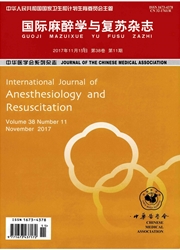

 中文摘要:
中文摘要:
目的探讨双腔支气管导管插管不能进入对应支气管的原因和解决办法。方法选取87例开胸手术需行双腔支气管导管插管进行双肺隔离通气病例。对每例预设和改变的双腔支气管导管型号、气管及支气管内径和走行情况、双腔支气管导管插管定位情况、气管内镜使用情况及所见、特殊情况等,结合CT所见进行分析。测如下数据:左支气管内径(ZN),右支气管内径(YN),左支气管与气管下半段轴线的夹角(ZJ),右支气管与气管下半段轴线的夹角(YJ),气管下半段轴线与身体纵轴夹角(QJ),右左支气管开口垂直直线距离在气管后段内径中的占比(YB、ZB)和其占比差(YB-ZB)。结果87例中27例气管偏移或变异,其中13例有右支气管导管插管顺利倾向定义为特殊右(TY),另14例有左支气管导管插管顺利倾向定义为特殊左(TZ);其余60例气管基本正常,49例选左支气管导管插管顺利定义为正常左(ZZ),11例选右支气管导管插管顺利定义为正常右(ZY)。TY与,IZ在ZJ、YJ、QJ和YB-ZB间,与zz在YJ、QJ和YB-ZB间,与ZY在QJ和YB-ZB间比较,差异有统计学意义(P〈0.05)。TY表现为:QJ右倾(8.08±5.94)°;ZJ角度偏向正常高限(47.46±7.28)°;YB-ZB明显大;YN相对其ZN宽,差异无统计学意义(P〉0.05)。TZ表现为:ZJ相对较小;YJ相对较大,与TY相比,差异有统计学意义(P〈0.05),与ZZ、ZY相比,差异无统计学意义(P〉0.05)。以上因素决定了气管后半段的趋向性,影响着双腔支气管导管插管的走向,双腔支气管导管插管不能进入对应支气管。结论插管前根据CT定位像中气管后半段趋向性,选择左或右双腔支气管导管插管,是解决双腔支气管导管顺利插入对应支气管的最简捷方法之一。
 英文摘要:
英文摘要:
Objective To analyze the tubing misplacement in double lumen bronchial intubation with computerized tomography (CT) for optimization of the procedure. Methods This study enrolled 87 patients subjected to major chest surgery with double lumen bronchial intubation for double lung ventilation. For each case, detailed information of bronchial intubation was collected with CT, including size of tubing, anatomical properties of trachea and bronchi, localization of double lumen endobronchial tubing. In some cases, tracheal endoscope was also performed. Results In 87 cases, the trachea of 27 cases deviated from normal positions or had aberrant shapes. In 13 of these 27 cases, the right, but not left, bronchial intubation was successful, while in 14 others, the left, but not right, bronchial intubation was successful. The other 60 cases had normal trachea. In 49 of these patients, left bronchial intubation was successful, and in other 11 patients, the right, but not left, bronchial intubation was successful. The correct placement of tubing is influenced by anatomy of trachea, bronchi and their junctions, including the diameters of bronchi, the angle between bronchus and the lower half of trachea, the angle between the longitudinal axis of trachea and that of the chest, the structure of the interface between proximal openings of right and left bronchi and the lower end of the trachea. Conclusions The anatomical complexity of trachea, bronchi, and their junctions are the major factors affecting the probability of the tubing misplacement in double lumen bronchial intubation. The guidance of simultaneous CT analysis may be an applicable strategy to avoid the misplacement.
 同期刊论文项目
同期刊论文项目
 同项目期刊论文
同项目期刊论文
 期刊信息
期刊信息
